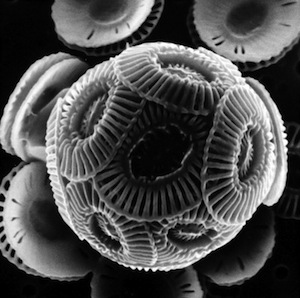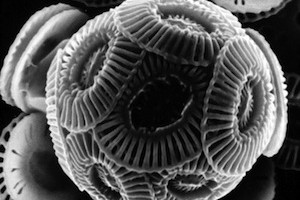
huxleyi.jpg
Scanning electron micrograph of Emiliania huxleyi, a type of marine phytoplankton whose blooms can grow so large they are visible from space. Researchers have found it does not require external supplies of vitamin B1 to grow, as previously thought. (Photo credit: Bjoern Rost, Alfred Wegener Institut)
A type of phytoplankton found all over the world appears to be able to survive without external supplies of vitamin B1, leading to a re-thinking of how the vitamin controls growth and carbon uptake in the global oceans. The availability of nutrients and vitamins in the ocean is a key limiting factor controlling blooms of phytoplankton, which in turn have a huge influence on the amount of carbon flowing in and out of the atmosphere.
The researchers have discovered that Emiliania huxleyi, a widespread type of phytoplankton that forms large blooms,is able to survive without any vitamin B1. Instead E. huxleyi produces its own vitamin B1 from a precursor molecule.
This means that the organisms may survive in places previously unexpected, i.e. where vitamin B1 is scarce.
Original research paper published in The ISME Journal on August 29, 2014.
Names and affiliations of selected authors
Alexandra Worden, Monterey Bay Aquarium Research Institute, U.S.A.
John Archibald, Dalhousie University, Nova Scotia
Lindsay Jolivet, Canadian Institute for Advanced Research

